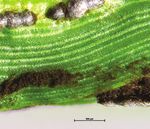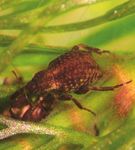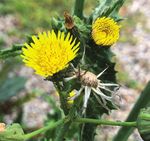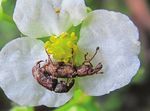Biocontrol of weeds Autumn 2018 update - New biocontrol solutions for sustainable management of weed impacts on agricultural profitability ...
←
→
Page content transcription
If your browser does not render page correctly, please read the page content below
Biocontrol of weeds
Autumn 2018 update
New biocontrol solutions for sustainable
management of weed impacts on
agricultural profitability
Weeds threaten Australia’s natural environment The New biocontrol solutions for sustainable
and rural industries. They displace native species, management of weed impacts to agricultural profitability
contribute significantly to land degradation, and project aims to improve the long-term profitability of
reduce agricultural productivity. primary producers affected by the target weeds by
developing novel biocontrol solutions that will reduce
AgriFutures Australia, through the Australian recurrent costs of control.
Government Rural R&D for Profit Program is
The target weeds are: African boxthorn, cabomba,
working with departments of agriculture in
prickly acacia, sagittaria, silverleaf nightshade,
NSW, Queensland and Victoria, and the CSIRO to
fleabane, sowthistle, mother-of-millions, giant rat’s tail
develop new biocontrol agents to target 10 weed grass and ox-eye daisy.
species that are significant on a national level —
weeds that are difficult to control with current
methods and have substantial impacts across
agriculture sectors.
Learn more
agrifutures.com.au/weeds-biocontrolBiocontrol of weeds
Autumn 2018 update
ABOVE: Collecting potential biocontrol agent for prickly acacia (Vachellia nilotica) in Ethiopia. ABOVE: Phd student Tahina Rajoanera collecting
Photo credits (clockwise from above): QDAF, NSW DPI, QDAF Rhembastus sp. BELOW: PhD student Guy Sutton
from Rhodes University inspecting Sporobolus
pyramidalis for insect damage in South Africa.
Why biocontrol? Why these weed species?
Successful targeted and integrated biocontrol Consultation with industry stakeholders identified and
programs deliver long-term solutions to soil, water and prioritised 10 target weed species. The criteria included
natural resource management problems. addressing significant impacts across multiple industry
sectors and the likelihood of successful control.
Australia has been a world leader in weed
biocontrol since the prickly pear success of the The target weeds impact cropping (fleabane, sowthistle,
silverleaf nightshade), pasture (African boxthorn,
1930s, with average benefit-cost ratios on R&D
mother-of- millions, ox-eye daisy, giant rat’s tail
investment in the order of 23:1. grass, prickly acacia) and water resources (cabomba,
Weed biocontrol programs involve: identifying new sagittaria), and collectively their impacts cost
effective agents (Phase 1), assessing the risk and Australian agriculture more than $400 million/year.
efficacy of such agents (Phase 2), followed by approval Approval process and next steps
for release in Australia, mass-rearing, large-scale
release and redistribution of these agents (Phase 3). Approval for the release of biocontrol agents requires
thorough assessment of impact and risks. This includes
The New biocontrol solutions for sustainable a detailed evaluation of the risks of the proposed
management of weed impacts to agricultural release (including host-specificity testing), including
profitability project specifically targets Phases 1 and pest status across each state, possible implications of
2. When Phase 3 is supported and agents approved for the weed’s biological control for affected industries and
release, the anticipated outcomes from the project will public consultation.
reach nation-wide.
The project brings together biocontrol expertise from
four Australian and multiple international research
agencies to support the development of these new
agents.
2Biocontrol of weeds
Autumn 2018 update
African boxthorn (Lycium ferocissimum)
DNA extracted from African Boxthorn quarantine and pilot studies to develop
samples from Australia revealed all local efficient inoculation methods for host
Photo credit: K. Ireland, CSIRO
specimens to be Lycium ferocissimum, specificity testing are underway.
with no evidence of hybrids. There are Two leaf-feeding insects (Cleta sp. and
several Lycium species in South Africa and Cassida distinguenda) show promise and
significantly more genetic diversity within colonies have been established in South
L. ferocissimum in Africa than Australia. Africa. Testing is examining the risk these
Ongoing work is determining the closest insects pose to species in the genera
genetic match in South Africa for the Lycium, Solanum and Capsicum.
Australian populations; candidate agents Pending successful results, the insects
will be sourced from these populations. Researchers
will be imported into an Australian
Two accessions of the promising rust quarantine facility for continued host- Raghu Sathyamurthy, CSIRO
fungus, Puccinia rapipes, have been specificity testing. Raghu.Sathyamurthy@csiro.au
imported into Australia. Cultures on Louise Morin, CSIRO
living plants have been established in Louise.Morin@csiro.au
Cabomba (Cabomba caroliniana)
Surveys in Argentina to assess field and Argentina have been imported into
specificity of potential biological control Australia and a colony of weevils is in
agents for cabomba, such as Hydrotimetes the process of being established under
natans, continue to show that the quarantine conditions.
promising weevil occurs only on this highly A draft test list of plants for assessing
Photo credits: K. Nagalingam, CSIRO
invasive aquatic weed. the risk H. natans may pose to non-target
A colony of H. natans is being established species in Australia has been developed.
in Argentina, where the insect will be
screened against three species of
cabomba, and up to six species in the
family Nymphaceae. Researcher
Adults from a population of H. natans from Raghu Sathyamurthy, CSIRO
the wetlands along the border of Paraguay Raghu.Sathyamurthy@csiro.au
Fleabane (Conyza bonariensis)
Close to 500 samples of fleabane have These species are being identified and
been obtained from the native (South a root-feeding beetle and scale insect
America) and invaded (Australia) ranges are being cultured in Brazil for further
for genetic analyses. evaluation.
Analysis of the samples collected in After identification, and preliminary
Australia indicate two distinct genetic host-specificity testing in southern Brazil,
groups, suggesting Australia has had candidate agents will be imported for risk
multiple introductions of fleabane. assessment in quarantine laboratories
A total of 245 herbarium samples from in Australia. A draft test list for this risk
Photo credit: S. Raghu, CSIRO
countries spanning the native range of assessment has been compiled. These
fleabane have been obtained and are species have been collected and are being
awaiting DNA sequencing and analyses. propagated to build up seed reserves in
This comparative analysis will identify anticipation of host-specificity testing.
locations likely to prove most profitable for Researchers
candidate biological control agents.
Raghu Sathyamurthy, CSIRO
Surveys in Brazil have identified up to a Raghu.Sathyamurthy@csiro.au
dozen insect species of interest and with
the exception of a rootworm, none appear Louise Morin, CSIRO
to occur on other non-target species. Louise.Morin@csiro.au
3Biocontrol of weeds
Autumn 2018 update
Giant rat’s tail grass (Sporobolus sp.)
The Sporobolus leaf smut, Ustilago to areas in Australia where GRT species
sporoboli-indici, found on giant rat’s tail are found. Field surveys have yielded
grass (GRT) during one of the surveys in more than 50 insects and pathogens,
Queensland is having a significant impact with at least two insects (the stem-
on the invasive grass species. galling wasp Tetramesa sp. and another
eurytomid wasp, Eurytoma sp.) showing
Photo credit: QDAF
Infected plants are stunted, void of
seedheads and easily pulled out of the potential as biological control agents.
ground. Early indications suggest this Impact studies in the field indicate
pathogen could be an excellent biocontrol Tetramesa sp. significantly reduces
agent for GRT in Australia. height, survival and reproductive output of
Infested leaf smut plants growing at the GRT. If this insect is suitably host specific,
Ecosciences Precinct, Brisbane have a it is likely to be a damaging agent. Researchers
number of infected shoots with sterile Laboratory cultures of both wasps, Joe Vitelli, QDAF
inflorescences and leaf dieback. The collected at two sites in the Limpopo Joseph.Vitelli@daf.qld.gov.au
pathogenicity of the leaf smut will be Province, are being established at Rhodes
tested on other Sporobolus species and University, South Africa. Michael Day, QDAF
key grass crops and pastures. Michael.Day@daf.qld.gov.au
Field host range studies at 14 field sites
A climate model will be used to highlight involve Tetramesa sp., among other Andrew McConnachie, NSW DPI
areas in South Africa climatically similar potential candidates. Andrew.Mcconnachie@dpi.nsw.gov.au
Photo credits: Andrew McConnachie, NSW DPI
Mother of millions (Bryophyllum spp)
Following a severe cyclone season in Developmental threshold experiments
Madagascar during early 2017, the location with O. tenuipes are ongoing. These trials
and collection during late 2017 of the will allow for degree-day models to be
two potential biological control agents developed, which in turn will inform
for mother of millions — the stem-boring how many generations the weevil could
weevil (Osphilia tenuipes) and the root- complete at each invaded locality in
feeding flea beetle (Rhembastus sp.) — Australia.
was successful. Field monitoring sites have been
Both agents have been imported and established by NSW DPI at Wee Waa
established in quarantine in Australia. and at Turrawan in NSW. Field sites will Researchers
A PhD student in Madagascar, Tahina be established by QDAF in Queensland
during 2018. Andrew McConnachie, NSW DPI
Rajaonera, will be studying the impact and Andrew.Mcconnachie@dpi.nsw.gov.au
host range of O. tenuipes and Rhembastus
sp. under open-field conditions. Michael Day, QDAF
Michael.Day@daf.qld.gov.au
Photo credits: Andrew McConnachie, NSW DPI
Ox-eye daisy (Leucanthemum vulgare)
Replicated no-choice feeding trials greater effect on growth of ox-eye daisy
examining feeding damage and than D. aeratana. As a result, NSW DPI
development of the potential biological is negotiating with CABI Switzerland for
control agent Dichrorampha aeratana on the opportunity to carry out testing in
ox-eye daisy have shown no effect on the Switzerland on both D. aeratana and C.
species of Asteraceae tested. These test trisulcatus. In preparation, seed from
species included several ornamentals several native Australian Anthemidae
Asteraceae, a native Brachysome and have been sent to CABI for cultivation.
lettuce.
Field monitoring sites have been
Developmental threshold studies for D. established by NSW DPI at Kosciusko Researcher
aeratana were delayed due to adult moths National Park and Mongarlo (NSW), as
from the culture not laying fertilised eggs. well as Mount Hotham (Victoria). At these Andrew McConnachie, NSW DPI
This issue has now been resolved. sites, plant population data were recorded Andrew.Mcconnachie@dpi.nsw.gov.au
During trials overseas, CABI Switzerland and soil samples collected to determine
recently discovered that a rhizome-feeding the viable seed bank component.
weevil (Chyphocleonus trisulcatus) has a
4Biocontrol of weeds
Autumn 2018 update
Sagittaria (Sagittaria platyphylla and S. calycina)
A phylogenetic ‘tree’ showing the Adults only emerged from two test plant
relationship between weevil larvae with species: larval numbers induced in this
the potential for use as biological control trial killed starfruit (Damasonium minus)
agents for sagittaria, collected in the USA plants at low water levels, while plantain
during 2015, has been developed using (Alisma plantago-aquatica) survived. As
genetic analysis. both species are winter deciduous and
Laboratory trials have commenced can also reproduce by seed, if they can
with crown-boring weevil (Listronotus set seed before water levels decline, the
sordidus) under day lengths and climatic population level impacts are predicted to
Photo credits: Raelene Kwong, DEDJTR
conditions for Darwin (NT), Cape York be negligible.
(Queensland) and the Riverina (NSW) to Field studies of these plant species to
determine effects on fecundity and larval determine prevailing water regimes will be
development. undertaken to explore this risk.
Testing of the crown-boring weevil showed
larval damage in all tested plant species
at high and low water levels, with no larvae
Researcher
developing to adults on plants growing at Raelene Kwong, DEDJTR
high water levels. Rae.Kwong@ecodev.vic.gov.au
Prickly acacia (Vachellia nilotica)
In addition to previous surveys carried out Prickly acacia leaf samples, native to
in Senegal during October 2017, a native Senegal, have been imported to Australia
range survey was conducted in Ethiopia for molecular studies.
during November and December 2017
A colony of gall mites (Aceria sp.) has been
to identify and source biological control
established on potted Australian prickly
agents for the high-invasive prickly acacia.
acacia plants (grown from seeds sourced
Two gall mites found on prickly acacia in from Australia) in a quarantine facility
Ethiopia have been imported into Australia at Pretoria, South Africa. New mite gall
for identification. development was observed on inoculated
A gall thrip (Acaciothrips ebneri), two gall plants within three weeks.
Photo credit: QDAF
mites (Aceria spp.) and a stem-galling fly In preliminary no-choice host specificity
(Notomma mutilum) from Senegal have tests, the gall mites induced galls only
been identified as prospective biological on the Australian prickly acacia and no
control agents. gall induction was seen on South Africa
Stem galls of N. mutilum collected prickly acacia sub species, highlighting
from Senegal have been imported into the gall mite as highly host specific at this
subspecies level. Researcher
quarantine at the Ecosciences Precinct,
Brisbane for colony establishment and Kunjithapathan Dhileepan, QDAF
host specificity testing. Kunjithapatham.Dhileepan@daf.qld.gov.au
Silverleaf nightshade (Solanum elaeagnifolium)
The Foundation for the Study of Invasive Prospective control agents will be tested
Species (FuEDEI), Argentina, has surveyed for host specificity in Argentina to rule
Photo credit: John Heap, PIRSA
and collected silverleaf nightshade out any clearly unsuitable options before
samples in Argentina. No prospective potential agents are imported to Australia.
agents have been recorded from these
surveys, however it is early in the growing
season and surveys are still underway.
The FuEDEI has targeted a high-priority
area in southern Buenos Aires with
intensive surveys during January 2018.
In anticipation that agents will be found, Researcher
test plants of commercially-important Greg Lefoe, DEDJTR
species have been grown. Greg.Lefoe@ecodev.vic.gov.au
5Biocontrol of weeds
Autumn 2018 update
Sowthistle (Sonchus oleraceus)
Bioclimatic modelling suggests the Of the six species of fungi found associated
southern European edge of common with sowthistle in Europe, an unidentified
sowthistle’s native range could be the rust fungus looks to be the most promising
candidate agent at this stage. Culturing
Photo credit: Catriona Nicholls
best option in the pursuit of enemies best
adapted to the climatic distribution of the of this fungus on sowthistle plants is
weed in Australia. underway to enable identification and the
study of its host specificity.
Of the 40 or more insects found so far on
sowthistle during field surveys in France, Preliminary host-specificity tests with
Italy, Portugal and Morocco, two gall insects these insect and fungal pathogen species
(Cystiphora sonchi, Tephritis formosa) will start at the CSIRO European laboratory
appear to have the most potential due to in France in early 2018.
their apparent host specificity. If the candidate agents pass these initial Researchers
To date, field observations of these species tests, they will be imported to Australia for Raghu Sathyamurthy, CSIRO
show them to be restricted to plants in the further risk assessment in quarantine. A Raghu.Sathyamurthy@csiro.au
genus Sonchus. Colonies of these insects draft proposed test list for this assessment
of have been established in the CSIRO has been compiled. Louise Morin, CSIRO
European Laboratory in France. Louise.Morin@csiro.au
Research organisations Partner organisations
CSIRO PIRSA
Sowthistle, African boxthorn, cabomba, fleabane SEQ Water
DEDJTR GRDC
Silverleaf nightshade, sagittaria Ravensthorpe Shire
USDA
QDAF
Prickly acacia, giant rat’s tail grass, mother-of-millions Goulburn Murray Water
Murrumbidgee Irrigation
NSW DPI Coleambally Irrigation
Mother-of-millions, ox-eye daisy, giant rat’s tail grass
Goulburn Broken Catchment Management
Authority
North Queensland Dry Tropics
Photo credits: S. Raghu, CSIRO, John Heap, PIRSA, QDAF, NSW DPI, Raelene Kwong, DEDJTR
Wyong Shire
Murray Local Land Services
Murrumbidgee Landcare
Central Murray County Council
NSW Office of Environment and Heritage
NSW National Parks and Wildlife Service
NSW Biocontrol Taskforce
Bundaberg Council
North West Local Land Services
Gladstone Council
HQ Plantations
This project is supported by funding from the Australian Government Department
of Agriculture and Water Resources as part of its Rural R&D for Profit program
Learn more
agrifutures.com.au/weeds-biocontrol
6You can also read



























































